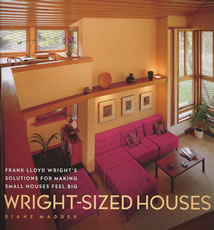| Authentic architecture [link] is highly condition-dependent. This fact can be seen throughout history and it has been consistent for all formal, as well as, vernacular architecture of great quality. Architecture is the expression of its society and it can be no other way. | | | And, conditions at any given time can be appropriate for the flowering of one kind of architecture and not others. In focus here is the question if the appropriate conditions exist today for the creation - at some significant scale - of affordable, sustainable housing for living, work and recreation, that the average working family can procure and maintain. | | | The standard by which I measure success in this venture is Frank Lloyd Wright’s Usonian Houses predominately built in the 1930s and 40s with some examples in the 1950s. I consider these houses to be the state-of-the-art of their kind and one of the greatest architectural achievements of all time. The purpose of the postUsonian Project is to restate and recreate this architecture in a way that is appropriate [link] to the 21st century and its conditions. | | A book that beautifully captures the spirit of these houses and the principles behind them is Wright-Sized Houses by Diane Maddex with photos by Christian Korab, Robert L. Wiser, Pedro E. Guerero, Tim Street-Porter and Michael Freeman. If you have an interest in this subject, this is a must-have for your bookshelf. It walks you through Wright’s and several of his client’s response to the challenge of designing and living in small, eloquent, affordable habitats from his Oak Park days throughout his career and afterwad with some of the work carried on by Taliesin Associated Architects. | |  | Wright-Sized Houses is a simply laid out book, full of beautiful photos (some samples to the left) and text that carefully explains what made Wright’s approach to the small house so effective. Not since The Natural House, written by Wright, published in the 1950s and now out of print, has someone spelled it out so completely. Diane Hadden is an author who not only understands - she also has a deep feeling for her subject. In scope, the book covers the entire length of Wright’s career from the Oak Park days to the Usonians and on to his last work. Because the book is of modest size and sticks to its theme, this presentation makes it possible to see not only the continuity and consistency of Wright’s approach but also his development as he pursued the ideal of the American home. After an overview, the book takes one concept and attribute of Wright’s work at a time, explains it and shows it with copious photos and plans. It then features a few Wright houses as examples. This book is an easy read. It also will reward returning to it time and again for careful study. I have bee studying Mr. Wright and his work for almost half a century and found many new tidbits of information and insights. I found the treatment of the post Wright works by sss and sss Lockhard and xxx, Fllw’s archivist, particularly appropriate. Wright-Sized Houses sets a good context for the many books now being published by and about owners of Usonian Houses [link]. Wright-Sized Houses is a guide, a manual and a reminder of how architecture can fit hand and glove with a way of living very much missing, today, from the modern experience. | | Isabel Roberst House - 1908
cover photograph by Christon Korab | | | First Jacobs House - 1936 | | | Pope-leighey House - 1939 | | Sturges House - 1939
photograph by Michael freeman | | | Zimmerman House - 1951 | | | Tracy House - 1955 | | The central question if there is a market today for this approach rests not on an esthetic judgment nor even on the mechanics of designing and building - as important as these are. It rests on the answer to the question if people want to live the way a home of this this sort requires. This was Mrs. Pew’s struggle when she first moved into her Usonian [link]. The fact that the Usonians, and the several other variants of small, simple, affordable modern architecture, faded away after the 1950s was not so much a failure of design. It was a change in the home owner’s mind regarding the concept HOME. | | | There are several conditions that make up this modern life that work for the return of the Usonian concept, several that work against it and some that tend to work both ways. An example of the latter is the general affluence of our society. On one hand, this increases the number who can afford a home. On the other, this affluence is based on a set of social behaviors and norms that work to exclude the kind of individualistic and hands-on approach a Usonian requires. You just do not go out and buy this kind of house, superficially decorate it with an eye on its future market value, live in it a few years then sell it like a commodity having “made” a lot of money [link]. Building codes and loan standards still remain a major obstacle to “unusual” architecture although there are signs that the lending market is beginning to wake up. Like the Usonian, postUsonian houses are likely to be built in a widely dispersed geographic pattern. Code and loans tend to be local if not in fact, in interpretation. interests that will resist change of this sort are definitely local. The postUsonian Project will have to project support broadly over a thinly populated opportunity terrain. This is always a difficult campaign. | | | Whatever the mix of pluses and minuses, the major issue will be that of attitude. A home like this does not come shrink nor do you put it in the social dumpster when you are finished with it. In a curious way, one thing that made the Usonians great was the effort it took to realize them. This acted as a significant filter. The filters are largely gone but many of the conditions remain. | | | | | Return To postUsonian Index | | | | | | Return To post Usonian Prototypes | | | | | Matt Taylor
Eslewhere
April 21, 2004 | 
SolutionBox voice of this document:
VISION • PHILOSOPHY • PROGRAM |
posted April 21, 2004 revised may 15, 2004
• 20040421.309392 • 20040515.366510.mt • (note: this document is about 25% finished) Matt Taylor 615 525 7053 me@matttaylor.com Copyright© Matt Taylor 2004 | |
|